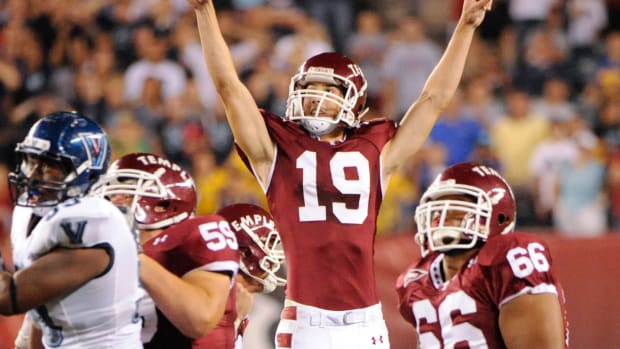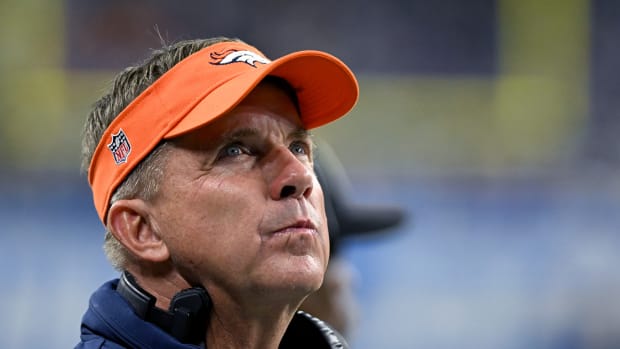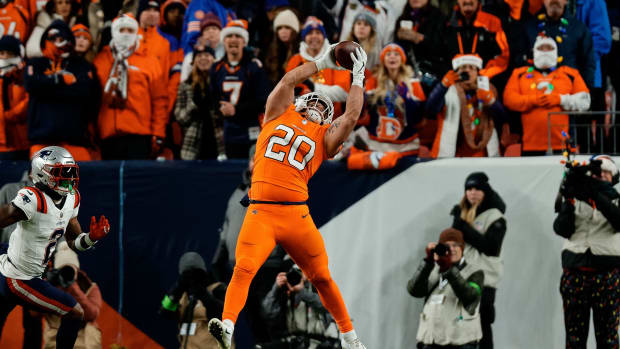4 Reasons Running Back is a Sleeper Need for Broncos Entering Draft
The Jacksonville Jaguars officially go on the clock with the first overall pick in the 2022 NFL draft in less than a week, and the Denver Broncos sit in a rather unfamiliar territory. The Broncos are not picking early in the draft and the team, on paper, has no obvious roster holes.
Of course, there are areas of the Broncos' roster that could be improved. The tight end position as it currently stands is one that has a low floor given neither Eric Tomlinson nor Albert Okwuegbunam seem to be the complete package and neither has been a primary tight end before.
Right tackle may have three options this season in Billy Turner, Tom Compton, and Calvin Anderson, but are any of the three quality options that would be preferred given the edge-rushing talent in the division? Edge rusher may look okay on paper but given Randy Gregory and Bradley Chubb’s history of missing games, does the team feel good about the depth at the impact position rushing the quarterback from the edge?
All valid questions and areas the Broncos could certainly look to improve this draft cycle.
The Broncos could legitimately go any position in the draft with almost any pick and, given the prospect's evaluation, not be making a “bad” decision. It’s always better to hit and find players on cost-controlled rookie contracts at the “value” positions such as offensive tackle, wide receiver, edge rusher, and cornerback.
However, with the Broncos' first pick not coming until No. 64 overall, it's simply more important to find players they believe will “hit” and can become contributors over their first four years in the league.
One position that could be argued as a solid need for the Broncos entering the 2022 NFL draft is running back — the position that has perhaps seen its perception and value plummet more than any other over the last decade. Wait, what? Yes. Running back is a need. Allow me to elucidate why.
Javonte Williams Still an Unknown
Without a doubt, the Broncos have one of the most exciting young running backs in the league in second-year player Williams. While Williams had an extremely exciting rookie season finishing fourth in the NFL in yards after contact per attempt at 3.42 (for backs with at least 200 carries), first with 31 broken tackles, and a Pro Football Focus elusiveness rating of 98.7 for second in the league, Williams was still in a timeshare, touching the ball 256 times compared to teammate Melvin Gordon’s 231 attempts.
With Gordon still unsigned, Williams is now set up to become the bell-cow back in Denver. However, exciting as it may be for fans of Williams to think about him touching the ball even more in 2022, is this a good thing for the Broncos’ offense this season?
The reality is, the more times a running back touches the football, the higher the chances that he suffers an injury that could result in a decline in play to varying degrees. Some backs have an innate ability to stay healthy or can play effectively through dings and bruises.
Some backs, however, cannot hold up over the larger volume of carries and are therefore better in a timeshare backfield. Is Williams the kind of back who can touch the ball over 300 times a season and retain his effectiveness? That answer is unknown because, simply put, he has not been asked to shoulder that large of a load.
Obviously, Williams was in a nearly 50/50 timeshare last season in Denver with Gordon, but even dating before that Williams was in a split backfield in college for North Carolina where Williams shared the backfield with now New York Jets running back Michael Carter. In 2019, Williams ran or caught the ball 183 times to Carters’ 198.
In 2020, Williams touched the ball 182 times to Carter’s 181. Williams has been in a 50:50 timeshare each of the last three seasons and has been effective in this partnership. Now, becoming a back that carries a larger share of the touches, could his play drop off and could he lose some of his effectiveness? That could be the case and is a possibility that should not be dismissed.
Russell Wilson's Passing Game Puts More Pressure on RBs
With the Broncos acquiring Wilson, some may state that even if Williams does become the bell-cow back this season, it won’t change his usage much due to the fact that Denver will now evolve into a pass-centric offense with its new franchise quarterback.
Given Wilson’s incredibly low volume of short-to-middle-of-the-field throws over his career to date, likely a downstream effect of his height limitation as seeing over the offensive and defensive lines is more difficult, and therefore, perhaps he's not as trusting to throw the ball blind to that area of the field.
Historically, Wilson does not utilize the short middle of the field area. It’s one of the reasons his completion percentage over expected stats are so astronomically higher than every single quarterback over the last half-decade. Wilson hits the harder throws outside the hash marks at a higher rate than other quarterbacks while not padding his completion percentage with the short middle of the field lay-up type of throws.
This hasn’t been as much of a problem for the functionality and effectiveness of offenses with Wilson to date, but in the dawn of the match quarters two-high safety shell world that current defenses are trending towards and away from the single-high cover 1 or cover 3 defenses, the middle areas of the field are starting to be given up by opposing defenses so they can better take away explosive passing plays. This could be a slight problem for how Wilson plays the quarterback position.
As The Athletic’s Nate Tice said on a recent podcast, the quick/short passing game and the running game in today’s NFL can be somewhat redundant. You need to be able to effectively do one to the point where opposing defenses must respect it enough to counter it via personnel and coverages that can better open up the explosive down the field pass plays.
Establishing the run to set up the play-action is a myth, but having the personnel in place that is talented enough forces opponents to value them from a bodies and scheme perspective does open up the explosive pass game.
With Wilson’s avoidance of the middle of the field, the pressure therefore falls on the Broncos’ ability to run the ball effectively to the point that opposing defenses cannot sit in two-high safety shells from nickel and dime packages.
Thus, the Broncos’ ability to run the ball effectively is an absolute must to force teams to play heavier boxes, and fewer two-high safety shells, is of the utmost importance to maximize a Wilson-led offense.
As was written in PFF’s 2021 QB Annual:
“Wilson can still be an elite player, but his targets continue to move further away from the middle of the field. His reliance on throws outside has been a staple of his game throughout his career, but if his accuracy is off by even a little Wilson begins to struggle.”
In order to maximize the explosive down-the-field plays with Wilson, Denver needs the personnel talented enough in the run game to make opposing defenses show looks that are more advantageous for creating explosive pass plays. That starts with just how much respect the Broncos’ running game can garner from opponents.
Mike Boone Also an Unknown
The Broncos paid Boone a relatively solid contract in 2021, considering his limited usage for the Minnesota Vikings in his career. After being given a two-year, $3.850 million contract last offseason and flashing some home run ability in camp, Boone suffered a significant quadriceps injury in the joint practice with his former team before the season.
Boone did see very limited action when Denver played at Kansas City, but overall, he is a projection as being a capable No. 2 running back in the NFL. At 5-foot-10 and 205 pounds, Boone is built more like a complementary back by today’s standards where the league is looking for more and more 220-plus pound backs to help hold up against free rushers in the back field and punish teams that are playing smaller linebackers, two-high safety shells, and lighter boxes in general.
Are bigger backs the future? Heck, they might even be the now. Over the last two years, the average weight for a 1,000-yard running back?
222.6 pounds.
The average weight for a top-10 rusher at the running back position? 220 pounds.
15 of the 18 backs to rush for 1,000 or more yards over the last two seasons were 220-plus pounds. The big backs are very much in vogue, and for good reason. At just over 200 pounds, though, Boone is not that type of back.
For his career, Boone has never touched the football more than 52 times in a single season. To go into 2022 with him as the unchallenged No. 2 back in a system where the touch distribution between the top two guys on the depth chart having such a disparity as 70:30 is risky for an offense that will likely be reliant on the effectiveness of their run game.
Green Bay's Personnel Decisions & RB Distribution
Further emphasizing the Broncos’ potential need for an additional running is the recent history of the Green Bay Packers. With the Broncos’ new head coach Nathaniel Hackett and offensive coordinator Justin Outten coming over from Green Bay and likely establishing a similar offense to that which they ran under Matt LaFleur with Aaron Rodgers, the Packers still valued the running back.
In 2020 with the 62nd overall selection, the Packers selected 6-foot-0, 247-pound running back AJ Dillon out of Boston College. Using a premium draft selection on the running back position when the team had a superstar quarterback on the team was met with some skepticism, especially considering the Packers already had the solid Aaron Jones on the roster.
Selecting Dillon was an easier sell as a succession plan to move on from Jones, an impending free agent, the following season — thus keeping the expenditures at the devalued running back position to a minimum.
It did not play out that way as the Packers turned around that following offseason and paid Jones a large contract of $48 million over four years. The Packers’ offense has been left wanting at the pass-catcher positions over recent seasons but with Hackett in Green Bay, the team seemed to truly value a solid investment in the running back position.
Was it the smartest move for the team? Given that those moves preceded Rodgers returning to form and winning back-to-back MVPs, it feels hard to criticize them too much with the benefit of hindsight.
'Running backs don’t matter' is a hyperbolic term to emphasize how silly it is to use first-round picks on the position or pay running backs second big contracts. The position tends to be one where a player is as good on his rookie contract as he'll ever be in his career, his abilities depreciate quickly, and it's a position that teams can find Day 2 and Day 3 of the draft every single year. However, the running back does matter if you properly valuate the position.
For the Broncos specifically, the RB2 spot seems like a massively overlooked position. Williams has not been a primary ball-carrier over the last three seasons, Boone is almost a complete unknown, and Wilson likely needs a strong running game to help create favorable looks and offset his avoidance of the short middle of the field.
Denver shouldn’t feel forced to walk away with a running back Day 2 or early Day 3 of the draft, if the value doesn’t match the slot, but given the offense’s likely dependence on a strong running game, a relative investment in the position shouldn't be overlooked as a legitimate direction for the Broncos. Nor should retaining Melvin Gordon before the start of the 2022 season be dismissed.
Follow Nick on Twitter @NickKendellMHH.
Follow Mile High Huddle on Twitter and Facebook.
Subscribe to Mile High Huddle on YouTube for daily Broncos live-stream podcasts!




